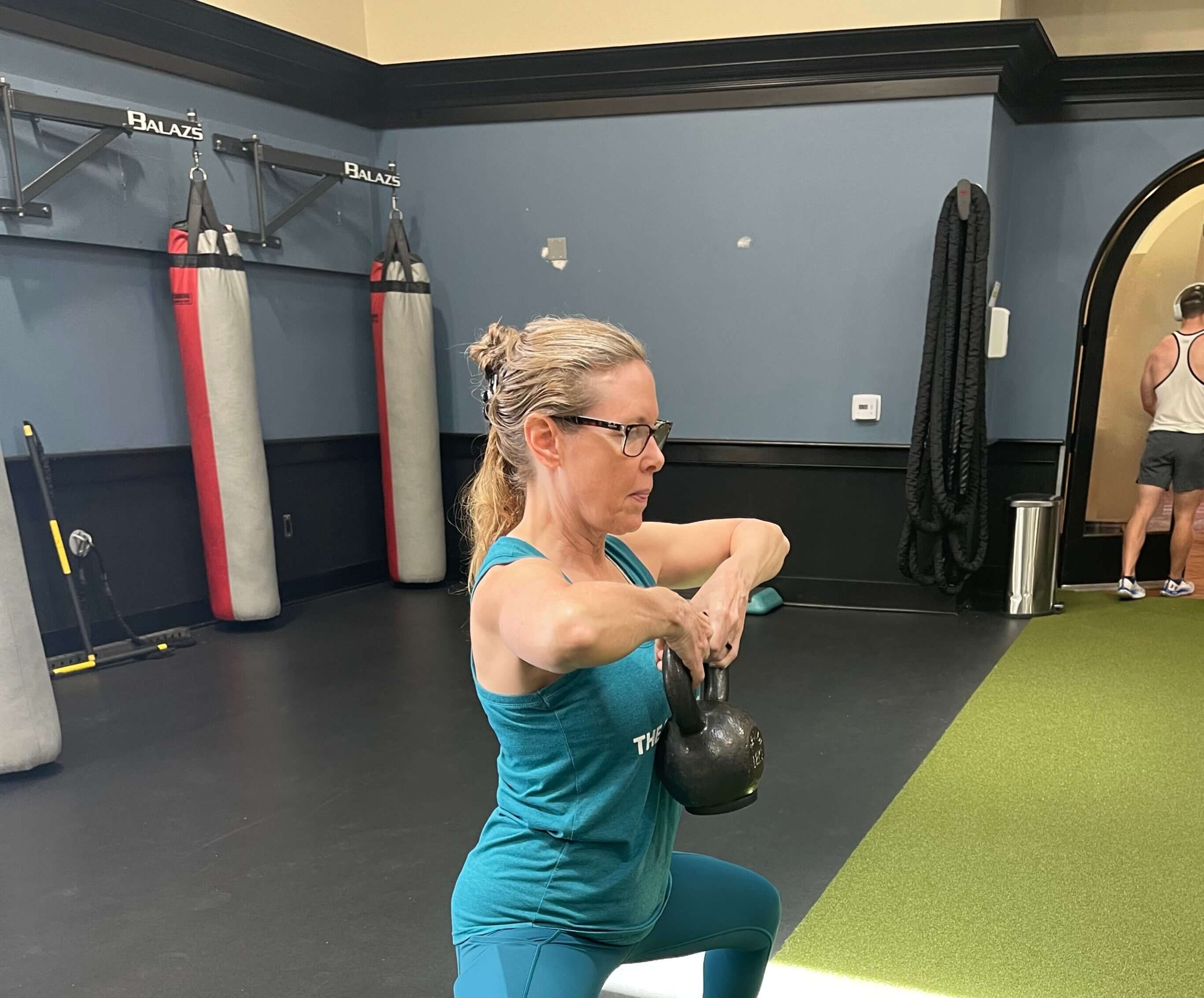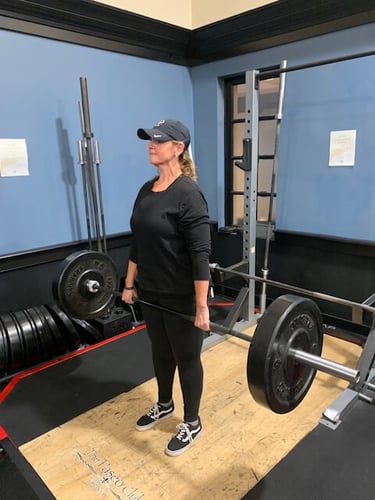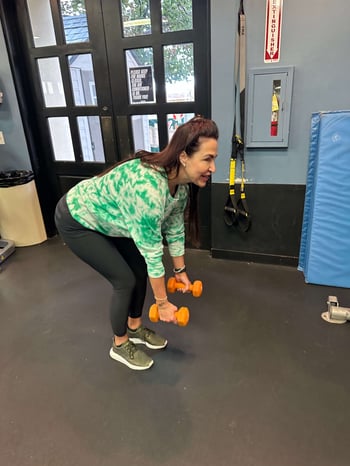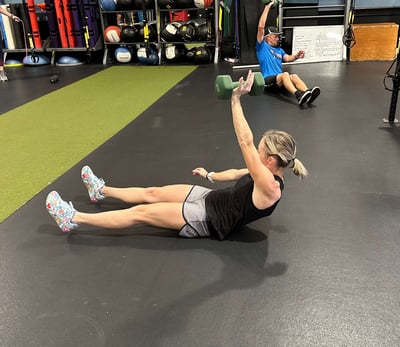
If you are like most of us, you are looking to up your fitness game. Maybe you want to increase your endurance for cycle class, play a better game of tennis, or crank out more burpees than ever before.
Traditionally, cardio was the exercise most recommended for improving your fitness. But recently, researchers have found that strength training dramatically helps improve your physique and increase your overall health and wellness.
But is strength training the panacea we think it is?
In this article, we will look at what strength training is, the types of strength training, and its pros and cons.
 What is strength training?
What is strength training?
Strength training (also known as resistance training) is a form of exercise that causes your muscles to work against external resistance. The outside resistance can be from your body weight, weight machines, free weights, resistance bands, and more.
Types of strength training
There are several forms of strength training, providing a variety of options to people of all ages and abilities. Use one method — or a few — to maintain diversity in your physical activity.
Bodyweight
Bodyweight movements are at the foundation of strength training. They are some of the most familiar and old-school exercises, but that does not mean they can’t give you a great workout.
You can develop entire workouts around bodyweight movements. They are great to do when you are at home or on the road when you don’t have access to equipment. Or integrate them into workouts along with weighted movements.
Typical bodyweight workouts are:
- Plank
- Sit-ups
- Lunges
- Burpees
- Push-ups
- Tricep dips
- Handstands
- Jumping jacks
- Squats and jump squats
 Free Weights
Free Weights
There are several types of free weights: medicine balls, dumbbells, kettlebells, and sandbags. Weights range from just a few pounds to 100 pounds or heavier. Almost everyone can use free weights.
You can use free weights on your own or in combination with other forms of resistance training. Use them at the gym, or purchase a few for your home gym.
There are dozens of movements that use free weights, providing you with a full-body workout.
- Curls
- Deadlifts
- Thrusters
- Russian twists
- Kettlebell swings
- Weighted lunges
- Weighted squats
- Overhead presses
- Weighted step-ups
- Weighted walks or sprints
Weight machines
Most people strength train by using the weight machines at their neighborhood gym for circuit training.
Weight machines use weights or pneumatic resistance. They allow you to train specific muscle groups for a “legs” or “arms and shoulders” day.
Weight machines are a good option if you are new to strength training and want a lower-risk method.
Some common weight machines are:
- Lat pulldown
- Leg extensions
- Seated arm curls
- Leg press machine
- Machine bench press
- Seated arm extensions
- Seated overhead presses
.jpg?width=275&height=413&name=pexels-klaus-nielsen-6303496%20(1).jpg) Resistance bands
Resistance bands
Resistance bands are elastic bands used for strength training or physical therapy. The bands are tubes with handles on either side or shaped as loops.
Bands are color coded for different resistance levels, allowing you to customize the type of resistance you want according to the movement and your ability.
Common exercises that use resistance bands are:
- Row
- Bicep curl
- Donkey kick
- Lateral raises
- Side leg raises
- Assisted pull-ups
.jpg?width=300&height=400&name=comp_IMG-3377%20(1).jpg) Suspension training
Suspension training
Suspension training involves straps with handles affixed to a wall or bar. Suspension systems allow the user to perform bodyweight movements in multiple planes — forward, backward, sides, and in rotation.
You adjust the level of complexity by the degree in which you position your body. The more parallel to the floor you are, the more difficult the movements are. Beginners can start by setting themselves at a 45-60 degree angle.
Suspension training forces the person to use their core muscles to stabilize themselves while exercising. This system is great for getting a full-body workout. TRX is the most well-known suspension training system.
Use a suspension system to:
- Row
- Plank
- Lunge
- Pull-ups
- Push-ups
- Hamstring pull
Olympic weight lifting
Olympic weightlifting has historically been considered a young mens sport.
We all have images etched into our brains of a big muscly dude picking up barbells weighing hundreds of pounds, grimacing, sweat pouring down his brow, then dropping the weight on the gym floor — the crashing sound reverberating throughout the room.
But the face of weight lifting is changing to include more women and older adults. With the proper training, Olympic weightlifting can be an effective (and exhilarating) sport to build more muscle power.
Types of Olympic weightlifting include:
- Deadlifts
- Snatches
- Back squats
- Front Squats
- Clean and jerks
- Bench Press
Water resistance training
Water provides natural resistance, which means water aerobics or lap swimming are forms of strength training. This is great news for older athletes or those with joint issues who need gentler and safer methods to strength train.
Exercises to practice in the pool are:
- Arm lifts
- Flutter kicks
- Wall push-ups
- Jumping jacks
- Treading water
- Walking or jogging in place
.png?width=408&height=330&name=crop_comp_weights%20-%20Edited%20(2).png) Pros of strength training
Pros of strength training
Strength training is not just about becoming stronger. There are significant physical, physiological, cognitive, and mental benefits too.
Burns body fat
Strength training burns body fat during and after exercise, a process called post-exercise oxygen consumption (EPOC), enabling the body to burn more calories throughout the day.
Reduces stress
When you strength train, your body releases endorphins — a “feel good hormone” — that reduces your perception of pain and lifts your mood.
Improves coordination
Strength training takes coordination and balance. You must move in a focused manner to obtain proper technique and prevent injury.
Better coordination and balance translate into improvement in other sports and reduce the chance of falling as you age.
Increases bone density
Osteoporosis is a bone disease that weakens bones and leaves people at risk for fractures. The stress placed on bones from strength training actually triggers the body to build bone cells, creating denser, stronger, and more resilient bones.
Improves quality of sleep
There is nothing like a good strength training session to calm the body and mind, preparing you for a good night's sleep.
Increases cognitive function
More and more research shows that exercise, including strength training, improves cognitive function and mental clarity. It also decreases the chance of Alzheimer’s, Parkinson’s, and dementia.
.png?width=400&height=486&name=Cropped_Compressed_pull-up%20-%20Edited%20(2).png) Improves heart and lung health
Improves heart and lung health
Cardio (or aerobic) workouts are characteristically associated with improving heart and lung health. But strength training is also effective.
Strength training can lower cholesterol and blood pressure levels, lowering your risk for heart attacks.
Lungs work harder when you strength train, which helps your lungs be more toned — just like your muscles.
Decreases anxiety and depression
Anxiety and depression are some of the most common mental health issues in the US and worldwide. Strength training not only changes a person’s chemistry, but it also affects their perception of themselves, boosting confidence and self-esteem.
Strength training has no side effects, so it is also a safe option for people looking to improve their mental and emotional well-being.
Increases muscle mass and strength
Strength training helps you develop muscle mass and strength through subtle damage and regrowth of your muscle tissue.
Increased muscle mass does not necessarily mean you will become big and bulky. Usually, a person who strength trains notices more definition and a more toned body.
Plus, you will get stronger, hitting PRs every few weeks or months, which is a great way to measure your progress.
Increase insulin sensitivity and improve glucose uptake
Diabetes is one of the most common diseases facing Americans today. There are many factors why people develop diabetes, but a poor diet and obesity are two significant risk factors.
Strength training can increase insulin sensitivity and improve glucose uptake in the body, which can help prevent or manage type 2 diabetes.
 Cons of strength training
Cons of strength training
Although strength training has many benefits, there are a few drawbacks to be aware of.
Sorer
Weight lifting can make you sore, especially if you do HIIT (high-intensity interval training) or heavy lifting. Mobility work is mandatory if you strength train to recover well and move with comfort throughout your day.
Need equipment
You can do bodyweight-based strength training (as mentioned above), but using free weights, machines, or Olympic lifting will increase the degree of challenge and provide more diversity in your programming.
Unfortunately, barbells don’t fit well in your suitcase, and they take up a lot of room if you put one in your living room for home training.
This means that if you want to weight train, it helps to have a variety of equipment. And the place that has that variety is the gym. Therefore, you must pay gym fees and plan to drive, park, and train there.
Increased risk of injury
The risk of injury is the biggest disadvantage of strength training. Strength training, especially when using weights, must be approached with the utmost attention to technique in order to be safe.
If you are not properly trained it is easy to strain or even damage muscles, tendons, or joints.
- Have correct form so that you target the correct muscles
- Take breaks between sets so that your body can have a mini-recovery
- Use the weight and rep scheme that challenges you but does not cause pain
- Warm up properly so that your muscles are prepared to train, and then cool down and mobilize to maintain flexibility and enhance recovery
- Start slowly, learning strength training in increments and adding weight gradually so that you have time to get stronger and become more skillful
- Don’t train through an injury — it will aggravate the injury and may cause strain in other areas of the body as you compensate for the pre-existing injury
- Workout with a personal trainer or in a group class so that you can be assessed and receive feedback about your technique, weight load, and programming
.jpg?width=325&height=433&name=comp_IMG-0106%20(2).jpg) 14 strength training classes at the Paseo Club
14 strength training classes at the Paseo Club
Now that you have read this article, you know what strength training is, what types of strength training you can try, and the pros and cons of strength training.
If you would like to try a strength training class and are in the Santa Clarita Valley, then check out the Paseo Club. We have several classes that are both fun and challenging! Whether you are a newbie or a pro, younger or older, there is a strength training class for you.
- LIFT
- Pilates Mat
- Liquid Cardio
- TRX and Core
- Cardio Strength
- Strictly Strength
- TRX and Pilates
- Pilates Reformer
- Chisel Challenge
- Strength and Tone
- Weighted Bootcamp
- Paseo Tribe HIIT Core
- Core, Tone, and Strength
- Blood Flow Restriction Training
Our two most popular classes are LIFT and Paseo TRIBE.
LIFT class is an hour-long class that features barbells, dumbbells, kettlebells, medicine balls, TRX straps, workout benches, and more.
Class has four components: warm-up, strength training, WOD (workout of the day that is 8-12 minutes of high-intensity interval training), and cool down. LIFT is a small group training class so you get lots of one-on-one instruction.
Paseo Tribe HIIT Core is a class for everyone, regardless of your fitness level. It increases your strength and endurance and burns fat. This class focuses on the muscles around your pelvis, hips, back and abdomen, leaving you with a slimmer waistline and stronger abs.You can get measurable results in just weeks!
The Paseo Club offers over 60 fitness classes each week. So if you want to mix up your strength training with cardio, yoga, barre, or something else, we have you covered.
Members also enjoy our tennis and pickleball courts, junior Olympic pool, cafe, and onsite spa. So once you finish your workout, stay for a dip in the pool, a relaxing lunch with friends, or a Swedish massage — or all three!
If you are looking for a home away from home, then the Paseo Club may be the place for you. Join now.
Jen Azevedo is a tennis professional, pickleball professional, personal trainer, group exercise instructor, and the general manager of the Paseo Club. She loves the community at the Paseo Club and that it is also a safe and fun place for her daughter. Jen’s favorite activities are joining her tribe for trail races or her partners for tennis matches. Occasionally Jen slows down to relax with a book — she reads over 100 a year!


